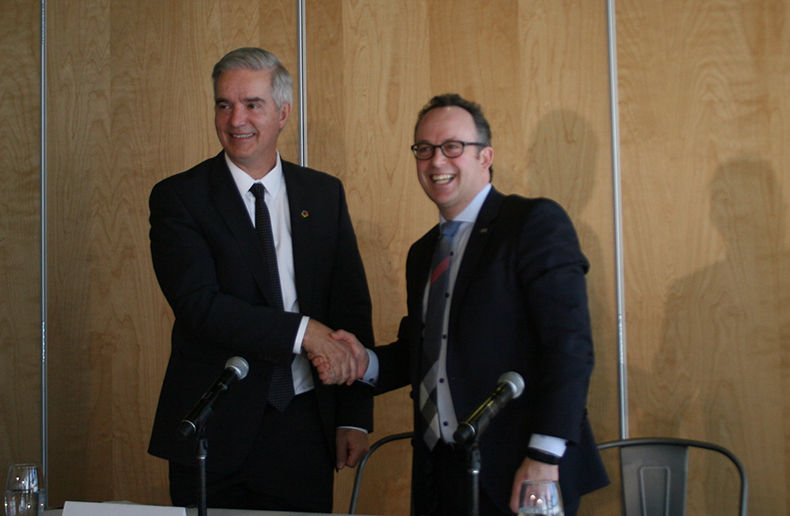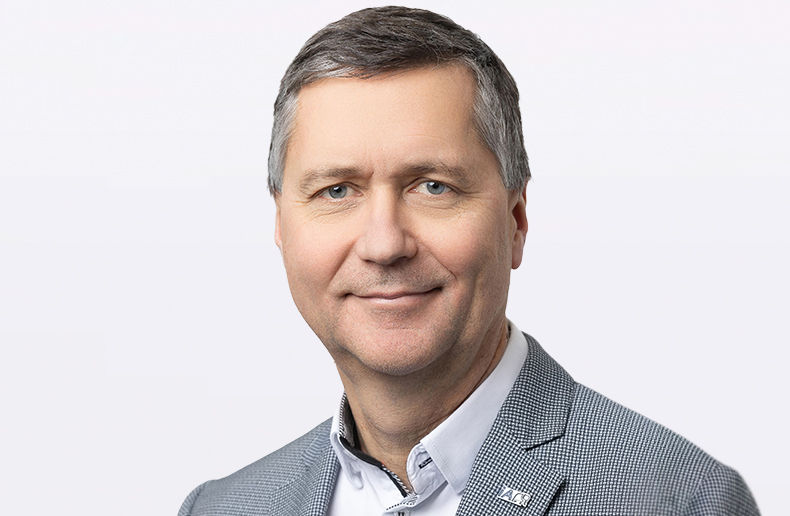The announced merger of La Capitale and SSQ Insurance, two insurance mutuals in the Quebec City region, aims to ease the digital transition that is an imperative for all insurers.
When it comes to recruiting employees, especially in information technologies, a large employer tends to be more attractive, said Jean St-Gelais, Chairman of the Board and Chief Executive Officer of La Capitale, and SSQ CEO Jean-François Chalifoux.
“In the IT sector, in all sectors it’s hard to recruit good candidates. After that, you need talent in every area,” St-Gelais said.
“By joining forces we will be an influential player in the insurance sector in Canada,” said Chalifoux. “We will have the capacity to make technological investments to pursue our transformation, accelerate the digital shift and execute many projects to benefit our members and clients.”
“We will be able to expand and optimize our line of products and solutions, and these products will now be better adapted to the needs of our increasingly varied clientele. Together we can offer clients a unique, distinctive experience,” he adds.
Targeting growth
The two insurers aspire to become the largest insurance mutual in Canada. Because they mainly operate in complementary markets, this merger was an obvious fit, said St-Gelais, who will chair the Board of Directors of the new entity once the transaction is authorized.
“We are effectively combining two complementary businesses of similar size, and common values, both of which are in excellent financial health,” he stated.
The new company will have a staff of 4,700, more than 3.5 million members and clients, assets under management of over $20 billion, and consolidated insurance premiums valued at $5 billion.
“The name of the new entity should resonate across the country, from Halifax to Victoria, by way of Montreal, Toronto, Calgary, Edmonton, Vancouver, etc.,” he says.
Elsewhere in Canada there are much bigger players than SSQ and La Capitale, but by joining forces Chalifoux says the organization will start nipping at their heels. “We envision developing faster in the rest of Canada; our new organization has market share to win,” he added.
Economies of scale
The two leaders stopped short of putting figures on economies of scale projected by the boards of directors of the two mutuals. Chalifoux, future CEO of the new entity, did confirm that the two mutuals would need to invest large sums to modernize their platforms in P&C insurance, La Capitale’s domain, and group insurance, SSQ’s specialty.
“Each of our organizations has its technological strengths, and we will continue to build on them. Without citing specific figures, we can say that the investments required will be in the hundreds of millions of dollars,” Chalifoux said.
Instead of investing separately, pooling their efforts will let the mutuals improve the client experience more quickly.
“We have to maintain our offering with our current clients. The operations of our two insurers, that are still competitors, must continue to flow smoothly. We are starting to work on the integration today. So we should be able to deliver the goods in terms of our cost saving estimates,” St-Gelais said.
Three years for integration
St-Gelais will chair the committee in charge of integrating the two organizations into one entity, in cooperation with Chalifoux. “We’re giving ourselves three years to successfully integrate...We always want it to go faster, we are executives after all, but we want it to be done right for the long term, for the continuity of our two organizations, mutuals that have been around a long time. We have no pressure to publish quarterly results like public companies do, with stock markets’ expectations in terms of personnel streamlining and synergy…Together we will succeed,” he says.
There are still some steps to follow before the group takes concrete form. “First we have to get the approval of the Competition Bureau of Canada, the Autorité des marchés financiers, the Québec finance ministry and the mutual policy holders of our two organizations,” St-Gelais explains. The National Assembly will also have to adopt amendments to the private bills governing each mutual. Ideally, this will happen by the end of the next parliamentary session, which begins next week.
“In the meantime, it’s business as usual. We are still two distinct independent companies. Today we are trumpeting our desire to merge, a magnificent project in our view,” St-Gelais says.
Mutual policy holders will meet on March 3 to decide whether to approve the proposed merger.
The two executives would not say who had put the merger project on the table. “It happened naturally in Quebec City. We’re a large industry but it’s still a small community, we all know each other, and we see each other often…It’s not really important to know who came up with the idea,” Chalifoux says.
“It really happened the way Jean-François told you,” St-Gelais echoed. “At the CLHIA, discussions on consolidation come up constantly. We often talked about it.”
“Through the different presentations that we gave in the past, the coming together of the mutualist environment, we have to find avenues for cooperation,” Chalifoux adds. “We are many small or midsized insurers. It is in all of our interest to pool our resources to develop. We have the same challenges, the same will to develop outside Quebec, and joining together makes a lot of sense if you want to penetrate the Canadian market.”
“It also took a bit of time to unfold,” St-Gelais continues. “I joined La Capitale in 2016, and Jean-François has been at SSQ since 2015. We needed to take the time to get to know our organizations well.”
“The world is evolving quickly...The labour shortage is worsening, and technology is advancing feverishly,” Chalifoux said.
“La Capitale’s presence in group insurance also gives us volume; we are already well-positioned,” Chalifoux notes. We are welcoming new clients, which lets us amortize the fixed costs over a larger number of clients, and a higher premium volume. It’s the same thing in P&C insurance and financial security. We are both present in these markets, so creating a new insurer that’s double the size is important. In our industry, a larger insurer can generate economies of scale regardless of its market.”
“We considered the size of both firms too small for the long term. By grouping together, we can face future challenges together. The cooperative mutualist model is widespread in Quebec with the Coopérative Fédérée, Agropur, Desjardins, Humania, UV Mutual, Promutuel, and us. It’s a model with a solid future. We believe in it and as proof we are forging ahead with this project.”
Workforce
Recruitment is increasingly difficult and successors are elusive. It is especially challenging to find specialized customer service agents and graduates of technical insurance programs, Chalifoux added.
“About 500 employees will be retiring in the next 3 to 5 years in both of our organizations. Normally, we have to hire hundreds of people each year. Today, in our two organizations we have over 200 vacant positions to fill,” Chalifoux revealed.
“If you are ambitious, talented and passionate, by all means send us your CV,” he commented.
By combining their volumes, the two insurers can harness their respective strengths to achieve savings, reduce costs and boost efficiency. “We have rivals, so if we want to be relevant and offer our clients a complete experience, we have to take the right steps,” St-Gelais added.







